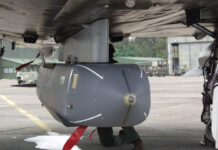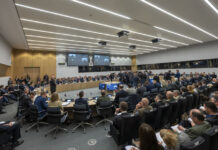France is a unique country within the EU. It maintains an independent – albeit costly – nuclear force and must protect its territories scattered across the globe. Similarly, the country is committed to achieving European strategic independence within NATO. While part of Europe’s rearmament since 2014, France faces challenges balancing these priorities alongside growing debt concerns.
France has recognised the emergence of new threats to the continent’s borders and a corresponding need to enhance its armed forces. A recent report from the National Assembly’s Defence Committee highlighted three notable aspects of the evolving situation: the increased use of force in international affairs, challenges to the Western model, and the strategic role of information in countering hostile narratives.
Strategic update
At President Emmanuel Macron’s request, the Military Programming Law (Loi de Programmation Militaire; LPM) was updated in response to recent geopolitical changes, resulting in the 2025 National Strategic Review published on 14 July 2025. The review highlights a broader range of threats and conflict zones, with increased ‘sub-threshold’ threats and renewed conventional state conflicts, stressing the need for larger military forces and readiness in land operations. The armed forces must prepare for multi-environment, multi-domain operations (MDO) that integrate both physical and cyber strategies. Expanding conflict zones and intertwined crises may affect the foundation of the Military Programming Law. France’s main aim is to strengthen European defence and deter Russia through robust nuclear deterrence. By 2030, France seeks full readiness for high-intensity warfare in Europe amid new priorities and emerging financial challenges.
Challenges in updating the Military Programming Law
The 2024–30 Military Programming Law increases defence funding to prepare for high-intensity conflicts. President Macron announced that the Ministry of the Armed Forces’ budget will reach EUR 64 billion by 2027, two years earlier than planned. Key priorities include drones, ammunition, electronic warfare, and ground-to-air defence systems. The extra funds will reinforce short-term response capabilities, replenish ammunition, invest in space, and revive select programmes, but there are no major structural changes or force expansions. The updated LPM seeks to bolster the defence industry, provide support for small and medium-sized enterprises, ensure the security of supply chains, and stimulate regional employment.
Several equipment targets may be brought forward by two to three years. In summer 2025, there was discussion about the low level of orders since the beginning of the year and the increase in deferred charges in 2024 – an accounting practice whereby equipment that has already been delivered is paid for the following year. To support its defence efforts, France is seeking extra funding amid a national debt exceeding EUR 3 trillion and annual interest payments of EUR 54.9 billion. The government plans to maintain its 2024–2030 Military Programming Law path, targeting a EUR 67 billion defence budget by 2030. On 20 March, the Economy Minister announced a EUR 450 million fund for investors in defence companies. France may also receive EUR 16 billion in favourable loans from the EU’s SAFE (Security Action for Europe) programme to boost military capabilities. For now though, the French defence industry is struggling to ramp up production as requested by the Ministry of the Armed Forces. The defence industrial and technological base comprises 4,500 SMEs and mid-cap companies, employing more than 200,000 people, 800 of which are considered ‘strategic or critical’ by the ministry.
The DGA annual report shows that the LPM sped up progress in 2024, while in 2025, over EUR 21 billion has been allocated for military equipment. An additional EUR 1.6 billion has been dedicated to future technologies, marking a substantial financial commitment. France continues to strengthen its status as a global leader in defence exports, with arms orders reaching EUR 18 billion in 2024, primarily due to contracts involving Rafale fighter jets, submarines, and CAESAR self-propelled howitzers (SPHs). While the French defence industry experienced setbacks in tender processes in Canada and Norway in September, it achieved notable success in Denmark with the surface-to-air SAMP/T (Sol-Air Moyenne Portée/Terrestre) missile system led by the Eurosam consortium.
Modernising power factors
There is an ongoing national discussion regarding whether to increase operational mass and reconsider the emphasis on high-technology approaches. A parliamentary report submitted on 11 June 2025 addresses both aspects, highlighting the need to develop a large force capable of sustained operations while incorporating advanced technological systems for operational effectiveness.
Army General Thierry Burkhard, the former Chief of the Defence Staff, previously showed that the Orion 2023 exercise provided insights relevant to force structure, particularly on the tactical use of drones, which requires further optimisation. The exercise also identified requirements for weapons with ranges between 50 and 500 km, as well as command systems suited for operations over these distances. In response, France is expanding its deep land strike capabilities through the Feux Longue Portée-Terre (FLP-T) programme, intended to replace the M270A1 Multiple Launch Rocket System (MLRS) and increase the number of such systems to 26 by 2035.
![Army General Thierry Burkhard was the architect of the French armed forces modernisation for several years. He stepped down from his position on 1 September 2025. [état-major des armées]](https://euro-sd.com/wp-content/uploads/2025/11/FRANCE2-Kopie-1024x699.jpg)
The air domain
Faced with increasingly contested airspace, the Air and Space Force (AAE) deemed it necessary to strengthen its fighter fleet. This need was highlighted by President Macron during his 18 March 2025 visit to the Luxeuil-les-Bains air force base, as part of France’s nuclear deterrence policy. At the end of December 2023, an order for 42 Rafale aircraft, known as ‘Tranche 5’, was placed with Dassault. The Ministry of the Armed Forces plans to deliver the Rafale to the F5 standard in 2030, as well as to place an order for the sixth tranche of production to the F5 standard in 2029. Of the 45 aircraft to be ordered, 12 will be for the French Navy to equip a flotilla.
In the short term, there are plans to increase the number of refurbished Mirage 2000D strike aircraft to 50, up from 47 currently, to compensate for the donation of Mirage 2000-5 aircraft to Ukraine. The number of A400M transport aircraft is also expected to increase from 35 to 37 by the end of 2028. The last French aircraft are now expected in 2032 instead of 2030, giving Airbus’ Spanish assembly lines some breathing space. The final number of A400Ms for the Air Force will depend on the EU-backed Future Medium-size Tactical Cargo (FMTC) programme, which aims to create an aircraft to replace the CASA CN-235 and C-130H Hercules.
Naval armament
The fleet reinforcement project is taking shape with the proposal by the French Navy Chief of Staff, to order three additional frigates. These would be defence and intervention frigates (FDI), the first of which, the Amiral Ronarc’h, intended for the French Navy, was delivered in September 2025. The FDI comparable performance to the multi-mission frigates (FREMM), and even exceed it in some areas, such as air defence thanks to the Sea Fire radar. The armament of these ships will not be modified, as integrating Sylver A70 launchers for naval cruise missiles (MdCN) is not planned. To address evolving threats, upgrades will be ordered for two new nuclear attack submarines (SNAs), as well as for the FREMM. These adaptations are included in the Military Programming Law for the period 2024–2030.
![The French Navy's receipt of the FDI Amiral Ronarc'h marks an important milestone in its rise. [marine nationale]](https://euro-sd.com/wp-content/uploads/2025/11/FRANCE5-Kopie-1024x684.jpg)
In the field of naval armament, efforts are underway to replenish ammunition stock and update effectors. The future anti-ship missile (FMAN), which is set to replace the Exocet in its surface-to-surface (MM40) and air-to-surface (AM39) versions, is currently under development by MBDA. This is an ambitious goal, as it is intended to replace the SCALP-EG cruise missiles. On the retrofit side, the ‘Exocet Évolutions’ programme aims to equip the AM39 and SM39 (fired from submarines) with the seeker developed for the latest version of Exocet, the MM40 Block 3C. Ministry documents indicate that delivery of a batch of F21 torpedoes has been postponed from 2024 to 2025 to integrate the latest software version of the homing device. Two batches are to be ordered this year, for a total of five batches of F21s to be delivered. In the aeronautics sector, a working group is looking into the continuation of the ATL 2 beyond 2035, while the first investments in its successor have been entrusted to Airbus, with a project based on the A321 XLR airliner.
Contributing to continental defence
France is currently contributing substantial troop deployments and has demonstrated an increased willingness to integrate NATO permanent forces and the Allied Reaction Force (ARF). In 2026, France will provide the land component and the CBRN Task Force of the ARF. By 2027, the army must have the capability to deploy a 19,000-strong division that can engage in operations within 30 days, while preparing two brigades as relief forces.
![The army's goal is to have the capability to deploy a division comprising two French brigades by 2027. [état-major des armées]](https://euro-sd.com/wp-content/uploads/2025/11/FRANCE7-Kopie-1024x720.jpg)
Falling behind the main allies?
The European dimension of rearmament is fundamental because no European country has the necessary resources to ensure its own security on its own. Nevertheless, there is an inverse relationship between distance from Moscow and growth in the defence budget. Despite the efforts of the LPM, France is lagging, attributable to its particularities outlined previously. Paradoxically, the army plans to augment its overseas personnel by 623 to address potential threats facing these territories.
Other European nations are strengthening their defence capabilities in order to protect the continent. Germany’s Defence Minister has stated a need for around 60,000 additional troops, while Chancellor Friedrich Merz has stated he aims to make the Bundeswehr “the strongest conventional army in Europe”. In the near term however, Poland looks to take the mantle of Europe’s most capable land force, slated to operate six divisions, with circa 1,100 tanks along with over 1000 tube and around 900 rocket artillery systems by the early 2030s. Despite its financial difficulties, the United Kingdom is expected to increase its defence spending to 2.7% of GDP by 2027, following approval by Parliament, though this effort will be more technological than human. Only Italy, which invests 1.6% of its GDP in defence, making it one of the lowest spenders in Europe, is not expected to increase its budget significantly. Nevertheless, the country will have among the most capable navies in the Mediterranean.
Efforts to improve efficiency and operational readiness
Leveraging existing resources, the French military authorities have prioritised operational readiness as a central objective within the LPM. The upcoming joint exercise Orion 26 represents a key milestone in this effort and will involve the mobilisation of thousands of participants. Simultaneously, the units are required to enhance their agility. For this reason, the army has initiated the ‘Armée de terre de combat’ reform, which addresses the shortcomings of prior reforms that diminished the responsibilities of command echelons and favoured efficiency at the expense of effectiveness, consequently limiting the initiative of commanders. The new objective is now established, granting Brigade commanders or equivalent, a broader autonomy to adjust structures and processes as needed.
In conclusion, international observers acknowledge the credibility of France’s deterrence strategy. According to a 2025 RAND report, France’s nuclear capabilities are viewed by Russia as both technologically and politically autonomous, thereby providing credible deterrence even amid significant ideological tensions. The associated costs are estimated to average approximately 0.7% of GDP over 50 years, including research expenditures, which remains comparatively modest. However, this cost may seem prohibitive today, given the difficult budgetary situation and the margins available for purchasing new equipment.
![The French Air and Space Force currently has an insufficient number of Rafale aircraft to fulfil all mission requirements in France, its overseas territories, and its operations. [état-major des armées]](https://euro-sd.com/wp-content/uploads/2025/11/FRANCE6-Kopie-1024x1024.jpg)
With the political outlook for autumn 2025 uncertain, France is currently struggling to adapt to evolving security threats and the ambitions of its European counterparts. Furthermore, the electoral objectives of political leaders seem to hinder their engagement with strategic and security concerns, which has an impact on France’s positioning on the international stage.
Jean François Auran














